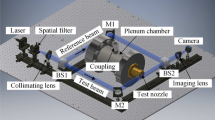Abstract
This paper describes the generation of high-speed liquid jets by the impact acceleration method using a vertical two-stage light gas gun specially designed and constructed for this project at the Interdisciplinary Shock Wave Research Laboratory, Institute of Fluid Science, Tohoku University. Results of pressure measurements and double exposure holographic interferometric visualization and high speed video-recording of shadow graph images of waves propagating in a conically shaped container of liquid are included. In the experiments, an optical fiber pressure transducer of 0.1 mm in diameter and resonant frequency of 100 MHz was used for precise pressure measurements of waves in the container at 300 m/s projectile impacts. To verify the contribution of longitudinal and transversal waves created in metal containers, we used a 10.6 mm × 10.6 mm container of water with thick acrylic observation windows and quantitatively visualized waves by using double exposure holographic interferometry. We found that: (1) longitudinal and transversal waves did exist in the metal parts of the container and also in the acrylic observation windows; (2) before the nozzle flow started, these waves and their reflected waves coalesced with the main impact generated shock wave; (3) the primary jet was driven by pressures of 12.4 GPa caused by the 300 m/s projectile impingement; (4) successive shock reflections inside the container of liquid drove intermittent multiple liquid jets; (5) the contribution of released longitudinal and transversal waves to multiple jet formation is marginal; and (6) negative pressures detected with the optical fiber pressure transducer are attributable to impact flash and have no physical significance.
Similar content being viewed by others
References
Bowden F.P. and Brunton J.H. (1958). Damage to solids by liquid impact at supersonics speeds. Nature 181: 873–875
Bowden F.P. and Brunton J.H. (1961). The deformation of solids by liquid impact at supersonic speeds. Proc. R. Soc. Lond. 263(A series): 433–450
Shi, H.H.: Study of Hypersonic Liquid Jets. Ph.D. thesis, Tohoku University, Sendai, Japan (1994)
Shi H.H., Takayama K. and Nagayasu N. (1985). The Measurement of impact pressure and solid surface response in liquid–solid impact up to hypersonic range. Wear 186–187: 352–359
Obara T., Bourne N.K. and Field J.E. (1995). Liquid-jet impact on liquid and solid surfaces. Wear 186–187: 388–394
Pianthong K., Zakrzewski S., Behnia M. and Milton B.E. (2002). Supersonic liquid Jets: their generation and shock wave characteristics. Shock Waves J. 11(6): 457–466
Shi H.H. and Sato H. (2003). Comparison-speed liquid jets. Exp. Fluids 35: 486–492
Pianthong K., Milton B.E. and Behnia M. (2003). Generation and shock wave characteristics of unsteady pulsed supersonic liquid jets. J. Atom. Sprays 13(5-6): 475–498
Bourne N.K. (2005). On stress wave interactions in liquid impact. Wear 258: 588–595
Pianthong K., Takayama K., Milton B.E. and Behnia M. (2005). Multiple pulsed hypersonic liquid diesel fuel jets driven by projectile impact. Shock Waves J. 14(1-2): 73–82
Pianthong, K.: Supersonic Liquid Diesel Fuel Jets: Generation, Shock Wave Characteristics, Auto-ignition Feasibilities. Ph.D. thesis, UNSW, Sydney, Australia (2002)
O’Keefe J.D., Wrinkle W.W. and Scully C.N. (1967). Supersonic liquid jets. Nature 213: 23–25
Ryhming I.L. (1973). Analysis of unsteady incompressible jet nozzle flow. J. Appl. Math. Phys.(ZAMP) 24: 149–164
Glenn L.A. (1975). The mechanics of the impulsive water cannon. Comput. Fluids 3: 197–215
Lesser M. (1995). Thirty years of liquid impact research: a tutorial review. Wear 186–187: 28–34
Pianthong K., Zakrzewski S., Milton B.E. and Behnia M. (2003). Characteristics of impact driven supersonic liquid jets. Exp. Therm. Fluid Sci. 27(5): 589–598
Milton, B.E., Watanabe, M., Saito, T., Pianthong, K.: Simulation of supersonic liquid jets using the Autodyne, In: Reddy, K.P. (ed.) Proceedings 25th ISSW (2005)
Ohashi, K.: Experimental characterization of flow fields. Master Degree thesis, Tohoku University, Sendai, Japan (2002)
Matthujak, A., Pianthong, K., Sun, M., Takayama, K., Ikohagi, T.: Characteristics of high-speed liquid fuel jets. In: The 16th Japanese Symposium of Shock Wave (2005)
Pecha, R.: Fiber optic probe hydrophone FOPH2000: Technical description and instruction manual including service information, RP acoustics, Germany
Staudenraus J. and Eisenmenger W. (1993). Fiber-optic probe hydrophone for ultrasonic and shock-wave measurements in water. Ultrasonic 31(4): 267–273
Tepper, W.: Experimetnal investigation of the propagation of shock waves in bubbly liquid-vapor-mixture. In: Archer, R.D., Milton, B.E. (eds.) Shock Tubes and Waves, Proceedings of 14th ISSW, pp. 397–404 (1983)
Author information
Authors and Affiliations
Corresponding author
Additional information
Communicated by B. Milton.
Rights and permissions
About this article
Cite this article
Matthujak, A., Hosseini, S.H.R., Takayama, K. et al. High speed jet formation by impact acceleration method. Shock Waves 16, 405–419 (2007). https://doi.org/10.1007/s00193-007-0079-9
Received:
Revised:
Accepted:
Published:
Issue Date:
DOI: https://doi.org/10.1007/s00193-007-0079-9
Keywords
- Pressure measurement
- High speed liquid jet
- High speed projectile impingement
- Shock wave
- Flow visualization




